
Power transmission and fluid power solutions provider Gates Corporation (NYSE:GTES) beat Wall Street’s revenue expectations in Q2 CY2025, but sales were flat year on year at $883.7 million. Its non-GAAP profit of $0.39 per share was 3% above analysts’ consensus estimates.
Is now the time to buy Gates Industrial Corporation? Find out by accessing our full research report, it’s free.
Gates Industrial Corporation (GTES) Q2 CY2025 Highlights:
- Revenue: $883.7 million vs analyst estimates of $875.3 million (flat year on year, 1% beat)
- Adjusted EPS: $0.39 vs analyst estimates of $0.38 (3% beat)
- Adjusted EBITDA: $199.2 million vs analyst estimates of $197.7 million (22.5% margin, 0.8% beat)
- Management raised its full-year Adjusted EPS guidance to $1.48 at the midpoint, a 2.8% increase
- EBITDA guidance for the full year is $780 million at the midpoint, above analyst estimates of $761.9 million
- Operating Margin: 13.1%, down from 15.4% in the same quarter last year
- Free Cash Flow Margin: 9.5%, up from 8.1% in the same quarter last year
- Organic Revenue was flat year on year (-4% in the same quarter last year)
- Market Capitalization: $6.37 billion
Company Overview
Helping create one of the most memorable moments for the iconic “Jurassic Park” film, Gates (NYSE:GTES) offers power transmission and fluid transfer equipment for various industries.
Revenue Growth
Reviewing a company’s long-term sales performance reveals insights into its quality. Even a bad business can shine for one or two quarters, but a top-tier one grows for years. Over the last five years, Gates Industrial Corporation grew its sales at a sluggish 4.2% compounded annual growth rate. This was below our standard for the industrials sector and is a rough starting point for our analysis.
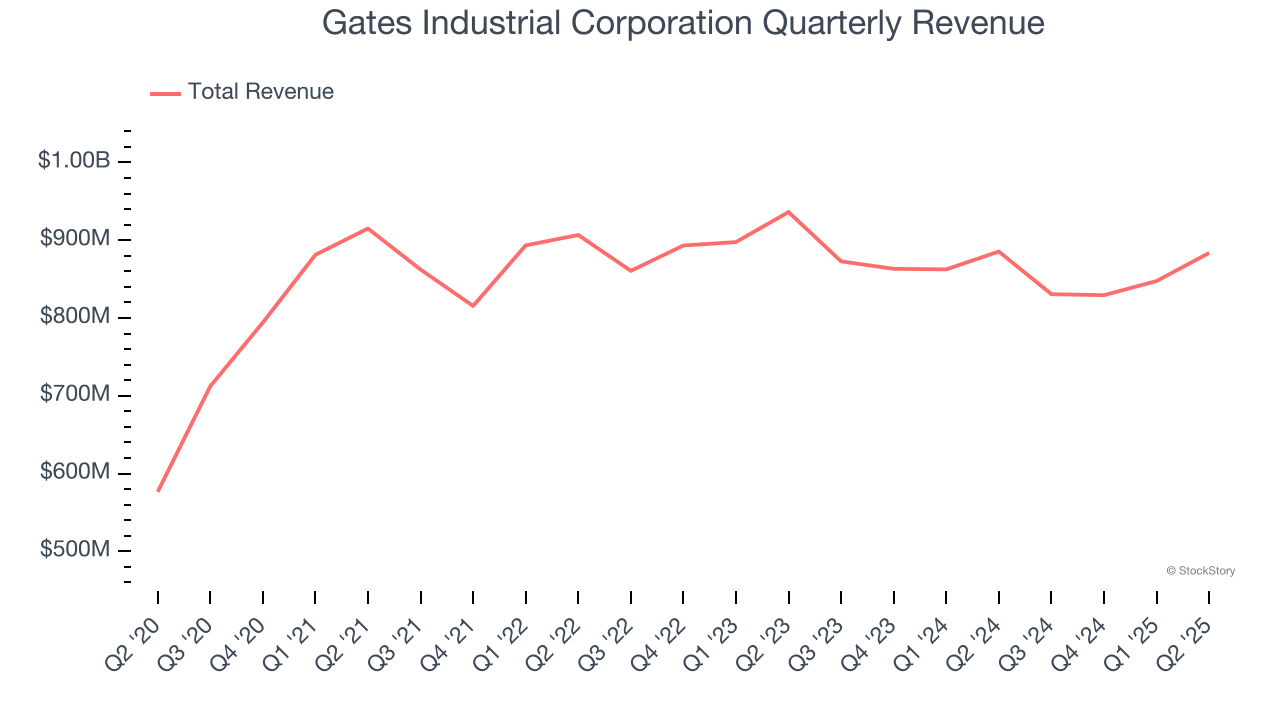
Long-term growth is the most important, but within industrials, a half-decade historical view may miss new industry trends or demand cycles. Gates Industrial Corporation’s performance shows it grew in the past but relinquished its gains over the last two years, as its revenue fell by 2.8% annually. 
We can better understand the company’s sales dynamics by analyzing its organic revenue, which strips out one-time events like acquisitions and currency fluctuations that don’t accurately reflect its fundamentals. Over the last two years, Gates Industrial Corporation’s organic revenue averaged 2.3% year-on-year declines. Because this number aligns with its normal revenue growth, we can see the company’s core operations (not acquisitions and divestitures) drove most of its results. 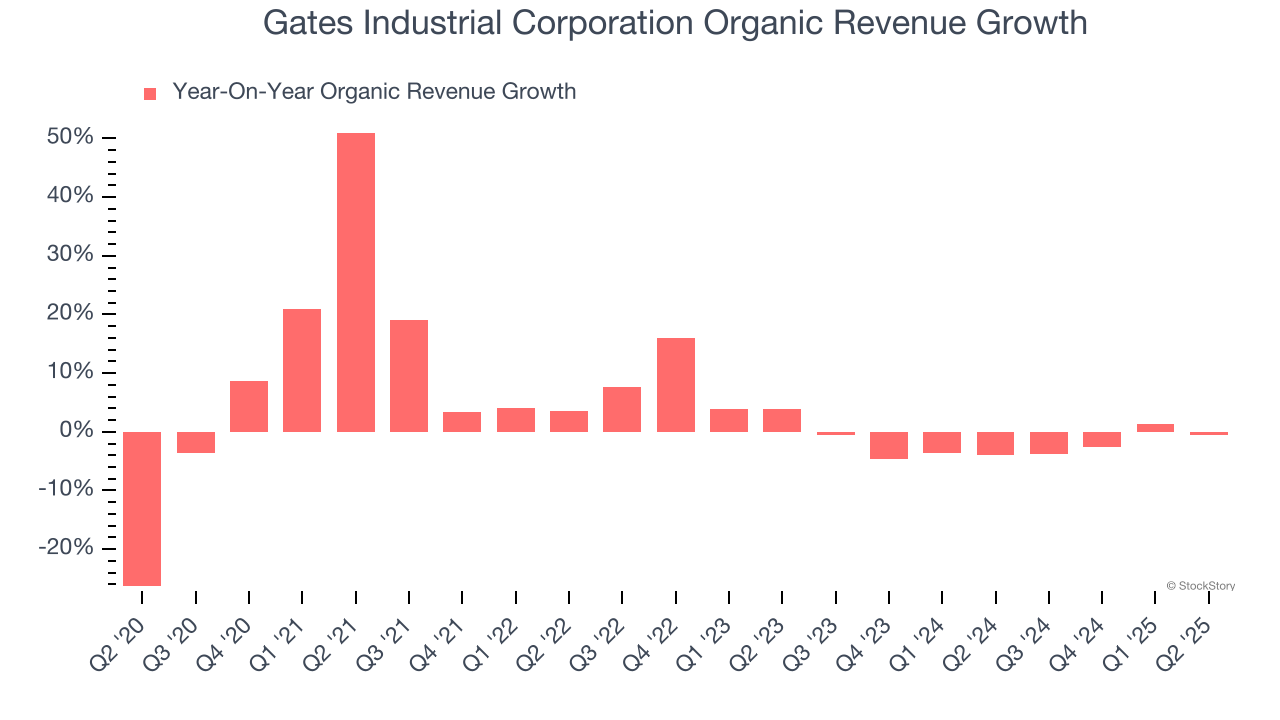
This quarter, Gates Industrial Corporation’s $883.7 million of revenue was flat year on year but beat Wall Street’s estimates by 1%.
Looking ahead, sell-side analysts expect revenue to grow 3.1% over the next 12 months. While this projection indicates its newer products and services will fuel better top-line performance, it is still below average for the sector.
Today’s young investors won’t have read the timeless lessons in Gorilla Game: Picking Winners In High Technology because it was written more than 20 years ago when Microsoft and Apple were first establishing their supremacy. But if we apply the same principles, then enterprise software stocks leveraging their own generative AI capabilities may well be the Gorillas of the future. So, in that spirit, we are excited to present our Special Free Report on a profitable, fast-growing enterprise software stock that is already riding the automation wave and looking to catch the generative AI next.
Operating Margin
Operating margin is a key measure of profitability. Think of it as net income - the bottom line - excluding the impact of taxes and interest on debt, which are less connected to business fundamentals.
Gates Industrial Corporation’s operating margin might fluctuated slightly over the last 12 months but has remained more or less the same, averaging 12.8% over the last five years. This profitability was top-notch for an industrials business, showing it’s an well-run company with an efficient cost structure. This result isn’t surprising as its high gross margin gives it a favorable starting point.
Looking at the trend in its profitability, Gates Industrial Corporation’s operating margin might fluctuated slightly but has generally stayed the same over the last five years. This raises questions about the company’s expense base because its revenue growth should have given it leverage on its fixed costs, resulting in better economies of scale and profitability.
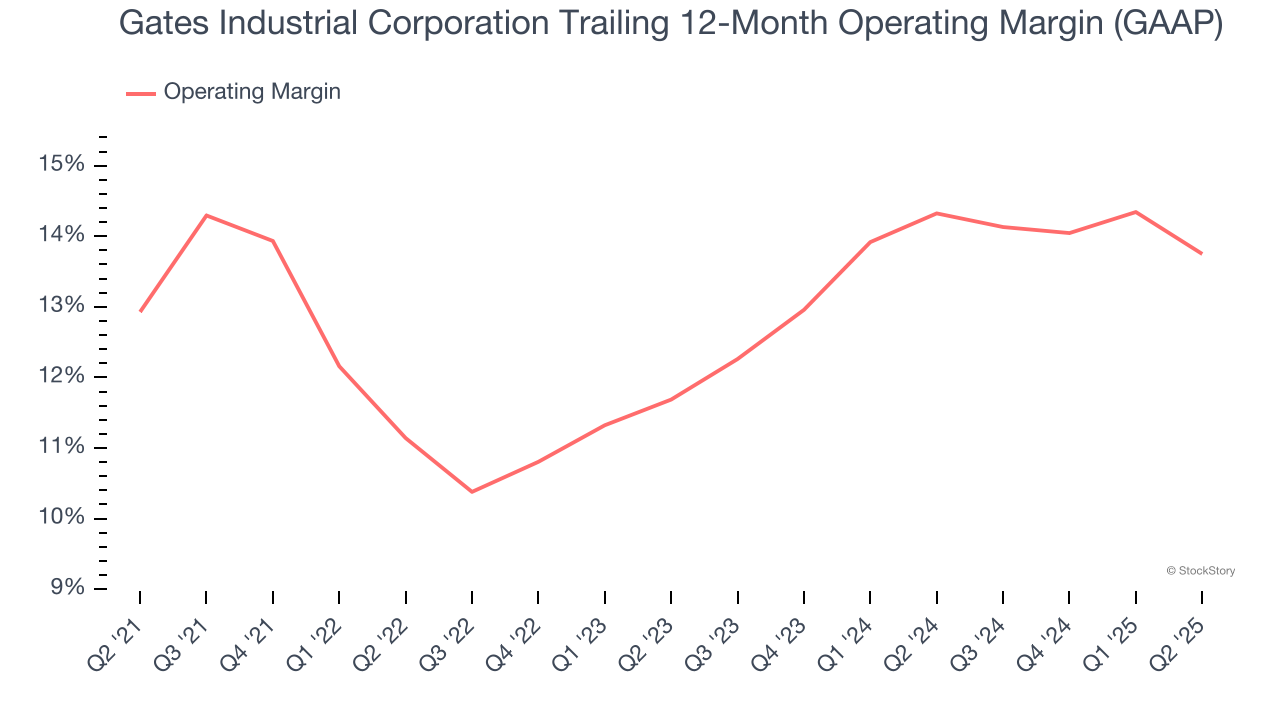
In Q2, Gates Industrial Corporation generated an operating margin profit margin of 13.1%, down 2.3 percentage points year on year. Since Gates Industrial Corporation’s operating margin decreased more than its gross margin, we can assume it was less efficient because expenses such as marketing, R&D, and administrative overhead increased.
Earnings Per Share
Revenue trends explain a company’s historical growth, but the long-term change in earnings per share (EPS) points to the profitability of that growth – for example, a company could inflate its sales through excessive spending on advertising and promotions.
Gates Industrial Corporation’s EPS grew at a spectacular 17.2% compounded annual growth rate over the last five years, higher than its 4.2% annualized revenue growth. This tells us the company became more profitable on a per-share basis as it expanded.
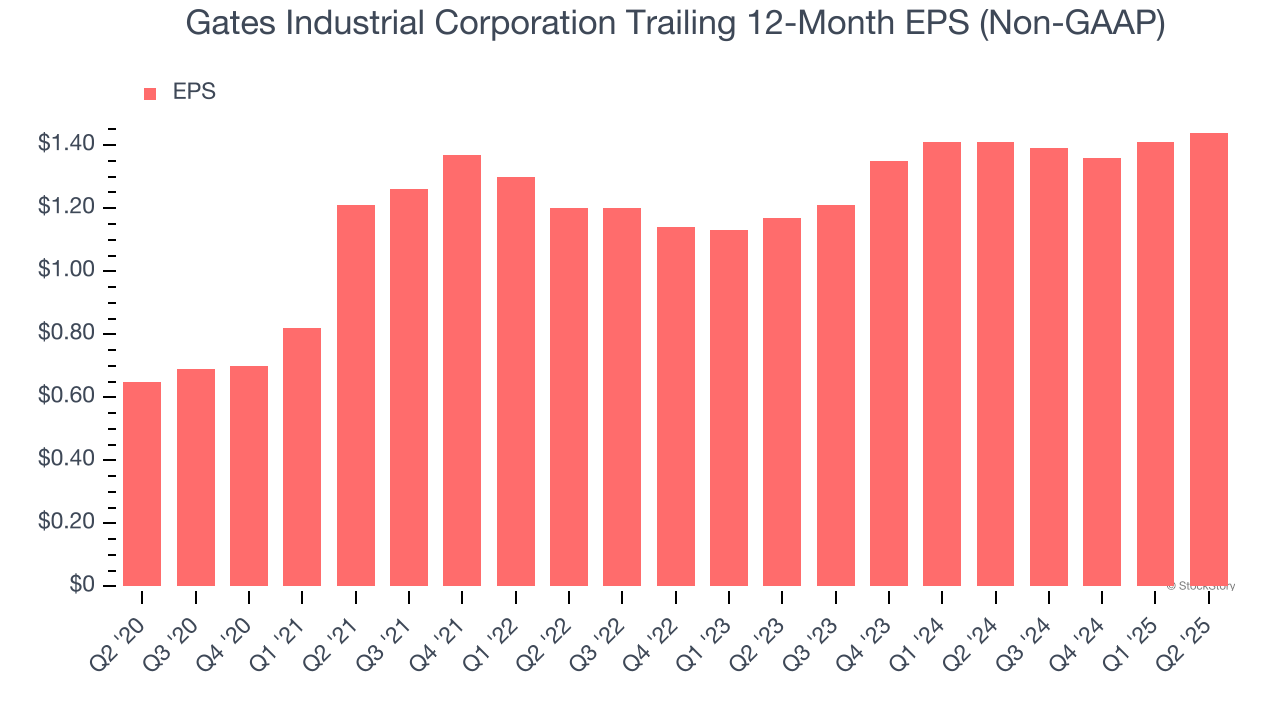
Diving into Gates Industrial Corporation’s quality of earnings can give us a better understanding of its performance. A five-year view shows that Gates Industrial Corporation has repurchased its stock, shrinking its share count by 10.4%. This tells us its EPS outperformed its revenue not because of increased operational efficiency but financial engineering, as buybacks boost per share earnings. 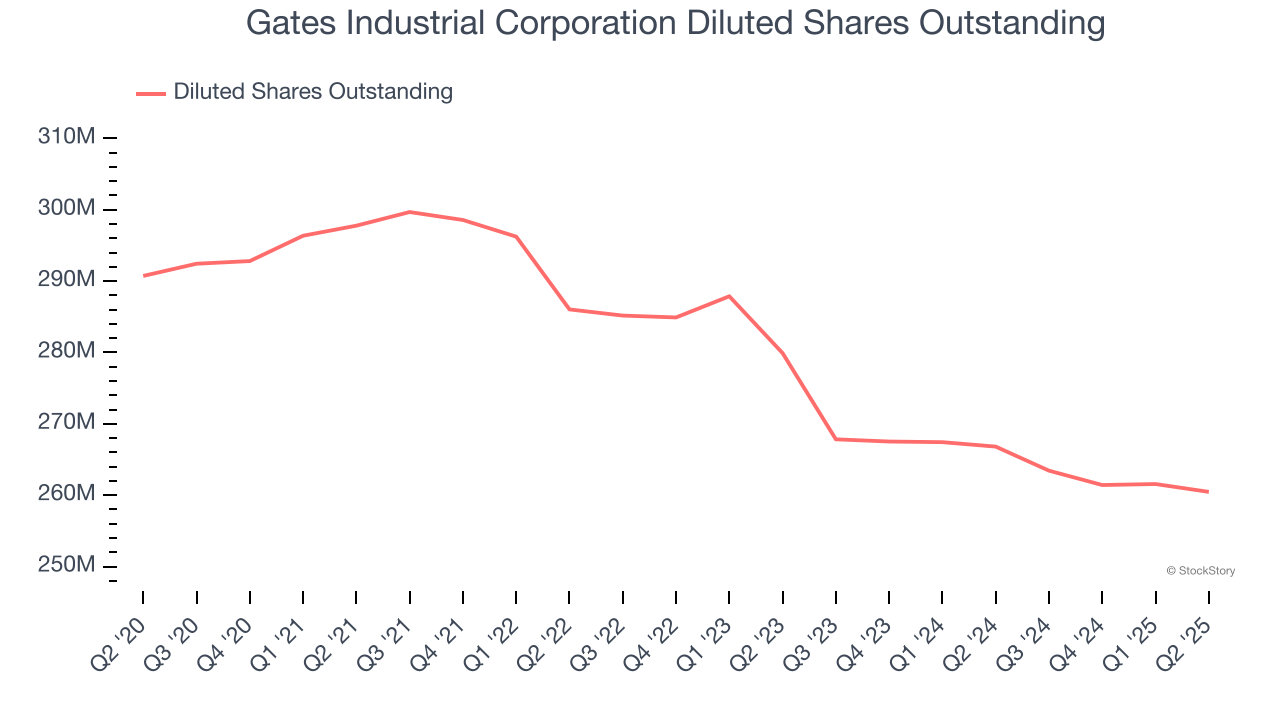
Like with revenue, we analyze EPS over a more recent period because it can provide insight into an emerging theme or development for the business.
For Gates Industrial Corporation, its two-year annual EPS growth of 10.9% was lower than its five-year trend. We still think its growth was good and hope it can accelerate in the future.
In Q2, Gates Industrial Corporation reported EPS at $0.39, up from $0.36 in the same quarter last year. This print beat analysts’ estimates by 3%. Over the next 12 months, Wall Street expects Gates Industrial Corporation’s full-year EPS of $1.44 to grow 5.9%.
Key Takeaways from Gates Industrial Corporation’s Q2 Results
It was great to see Gates Industrial Corporation’s full-year EBITDA guidance top analysts’ expectations. We were also happy its revenue narrowly outperformed Wall Street’s estimates. On the other hand, its organic revenue slightly missed. Still, this print had some key positives. The stock traded up 1.1% to $25 immediately following the results.
So should you invest in Gates Industrial Corporation right now? The latest quarter does matter, but not nearly as much as longer-term fundamentals and valuation, when deciding if the stock is a buy. We cover that in our actionable full research report which you can read here, it’s free.
